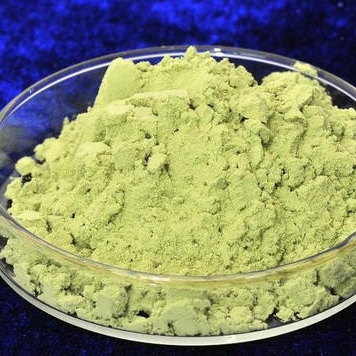| Chemical Properties | Molybdenum trioxide is an odorless, white crystalline powder that turns yellow when heated.

Molybdenum trioxide is perhaps the most important compound of molybdenum. Pure molybdenum trioxide is used in chemical and catalyst manufacture. The technical product is added to steel as an alloying agent. Molybdenum trioxide also serves as a catalyst in the petroleum industry and as a component of ceramics, enamels and pigments.
|
| Physical properties | Soft white powder; orthorhombic crystals; turns yellow on heating; density 4.69 g/cm3 at 21°C; melts at 795°C without decomposition to a dark yellow liquid; vapor pressure 20 torr at 851°C and 200 torr at 1,014°C; boils at 1,155°C; sparingly soluble in cold water (1.066 g/L at 18°C) and moderately soluble in hot water (20.55 g/L at 70°C); dissolves in acids and alkalies. |
| Uses | Molybdenum(VI) oxide is used in catalyst compositions to carry out desulfurization of petroleum feedstocks and to remove nitrogen-containing compounds from petroleum fractions. Other uses of this oxide include preparation of various molybdate salts and as reagents for chemical analyses.
|
| Uses | Chiefly as a reagent for chemical analysis.Used for trace metal analysis. |
| Uses | Molybdenum trioxide (MnO3) is a compound used to make enamels adhere to metals. |
| Definition | ChEBI: Molybdenum trioxide is a molybdenum oxide. |
| Preparation | Molybdenum(VI) oxide is obtained by igniting molybdenum or its compounds in air:
2Mo + 3O2 → 2MoO3
2MoS2 + 7O2 → 2MoO3 + 4SO2
MoS2 + 4O2 → MoO3 + SO2 + SO3
Roasting the sulfide is carried out in a multiple-hearth roaster under controlled temperature and airflow. The product mixture is sublimed to obtain high purity oxide.
Purified molybdenum(VI) oxide also is made by prolonged heating of ammonium molybdate in air:
(NH4)2Mo2O7 → 2MoO3 + 2NH3 + H2O
An alternative method involves repeatedly evaporating a mixture of ammonium molybdate and nitric acid. Ammonium nitrate so formed is separated from the product molybdenum(VI) oxide by extraction with water:
(NH4)2Mo2O7 + 2HNO3 → 2MoO3 + 2NH4NO3 + H2O
|
| General Description | Colorless to white or yellow odorless solid. Sinks in water. |
| Air & Water Reactions | Insoluble in water. |
| Reactivity Profile | Molybdenum trioxide reacts violently with chlorine trifluoride, lithium, potassium and sodium. Readily combines with acids and bases to form a series of polymeric compounds. Incompatible with interhalogens and metals. A violent detonation occurs when heated with molten magnesium. |
| Hazard | Toxic material. |
| Health Hazard | Compound is relatively nontoxic. Dust irritates eyes. |
| Fire Hazard | Flash point data for Molybdenum trioxide are not available, but Molybdenum trioxide is probably non-flammable. |
| Flammability and Explosibility | Nonflammable |
| Safety Profile | Poison by ingestion,
subcutaneous, and intraperitoneal routes.
Human systemic effects by inhalation:
pulmonary fibrosis and cough. Questionable
carcinogen with experimental neoplastigenic
data. A powerful irritant. Explodes on
contact with molten magnesium. Violent reaction with interhalogens (e.g., bromine
pentafluoride, chlorine trifluoride).
Incandescent reaction with hot sodium,
potassium, or lithium. When heated to
decomposition it emits toxic fumes of Mo. |
| Potential Exposure | Molybdenum trioxide is used in
agriculture; manufacture of metallic molybdenum, ceramic
glazes; enamels, pigments, and in analytical chemistry. |
| Shipping | UN2811 Toxic solids, organic, n.o.s., Hazard
Class: 6.1; Labels: 6.1-Poisonous materials, Technical Name
Required. |
| Purification Methods | Crystallise it from water (1g/50mL) between 70o and 0o. The solubility in H2O is 0.1% at 18o, and 2% at 70o. It is a white powder which turns yellow reversibly on heating. It sublimes readily at 1155o/760mm. [Hein & Herzog Handbook of Preparative Inorganic Chemistry (Ed. Brauer) Academic Press Vol II p 1412 1965.] |
| Incompatibilities | Explodes on contact with molten
magnesium. Violent reaction with strong oxidizers, such as
chlorine trifluoride; bromine pentafluoride. Not compatible
with strong acids; active metals (sodium, potassium,
lithium). |



